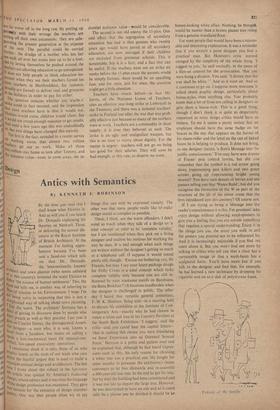Antics with Semantics
By KENNETH J. ROBINSON I 3111 . pheated way of talking about town planning. 41:ar the worst. The architects' Institute has a 4°4 of getting its discourse done by people who don preach as well as they practise. Last year it leave us Charles' Eames, the distinguished AmeH- an designer—a man who, it is said, kuows a hawk. from a handsaw, but insists on calling a spade a non-mechanical basis for manual-con- trolled, loW-speed excavatory operations. I sometimes think it is only those of us who eniploy words as the tools of our trade who care about the fearful jargon that is used to build a ri.lYstique around design and architecture. The last t wrote about this subject in the Spectator ti`ne article was quoted by America's Industrial 0:sign, whose editors said it was time the language , the design profession was examined. They gave `W9 reasons for the existence of design Mumbo- junTho. One was that people often try to say things that can only be expressed visually. The other was that some people really like to make design sound as complex as possible.
TheSe, I think, are the worst offenders. I don't mind so much when they talk of a design as 'a total concept' or refer to its 'complete validity,' but I am maddened' when they pick on a living, designer and analyse his motives for working the way he does. It is had enough when such things are written without the designer's getting so much as a telephone call. (I suppose it would sound pretty silly though : 'Excuse me bothering you, Sir Francis, but may I say your latest package design for Frilly Crisps is a total concept which lacks complete validity only because you are still in.- fluenced by your madonna motifs on Bambinos, the Betta Brekfustr.) It becomes insufferable when the designer is challenged in public. The other day I heard that versatile general consultant, F. H. K. Henrion, being told—at a meeting held to discuss his exhibition at the Institute of Con- temporary Arts—exactly why he had chosen to create a white oak tree in his Country Pavilion at the 'South Bank Exhibition. 'I suggest,' said the critic—and you could hear the capital letters— 'that in making this choice you were translating an Inner Experience into an Outward Sensual Form.' Henrion is a polite and patient man and he explained that, although he had heard expres- sions such as this, his only reason for choosing a 'white tree was a practical one. He fought for some months to persuade the exhibition's theme conveners to let him dismantle and re-assemble a 400-year-old oak tree. In the end he got his way, but by then the building had been constructed and it was too late to import the large tree. However. he was determined to have an oak and as it could only be a plaster one he decided it should he an honest-looking white affair. Nothing, he thought, would be nastier than a brown plaster tree rising from a genuine woodland floor.
For most people that would have been a reason- able and interesting explanation. It was a reminder that if you scratch a good designer you find a practical man. But Henrion's critic seemed enraged by the simplicity of the whole thing. 'I suggest to you.' he said excitedly, in the tones of a film-set counsel for the prosecution, 'that you were being a dictator. You said, "I dictate that the tree shall be white." ' And so it went on. And so it continues to go on. 1 suppose more nonsense is talked about graphic design, particularly about house-styles, than anything else. You probably know that a lot of firms are calling in designers to give them a house-style. This is a good thing, though I don't think it is quite as desperately important as sonic design critics would have us believe. To me it seems a pretty notion that an employee should have the same badge on his braces as the one that appears on the funnel of his steam-roller and the label on the can of baked beans he is helping to produce. It does not bring, as one designer claims, 'a fires Message into the public consciousness.' You.may have seen dozens of Fisons' pest control lorries, but did you remember that the symbol is a red arrow' going down (representing pest killer) and two green arrows going up (representing bright young shoots)? You have seen dozens of lorries and site posters telling you that 'Wates Build'; but did you recognise the formation' of the W as part of the structure of the jib of the tower crane that the firm introduced into this.country? Of course not.
if I am trying to-bring a Message into the reader's consciousness it is this: For goodnesg' sake enjoy design without allowing word-spinners to give you a feeling that you are outside something that requires a special,' understanding. Enjoy it in the things you use, the street you walk in and the posters you pretend not to be influenced by. And it is increasingly enjoyable if you find out more about it. But you won't find out more by talking to critics who tell you that a chair has a memorable image or that a wash-basin has a sculptural form. You'll have more fun if you talk to the designer and find that, for example, he has learned a new technique by dropping his cigarette end on to a slab of polystyrene foam.
'Frienits of the family.'










































 Previous page
Previous page